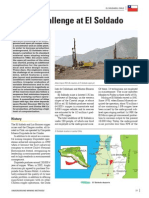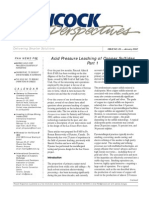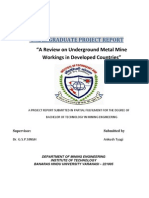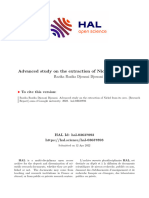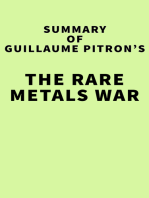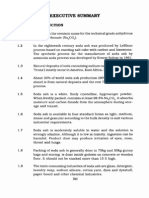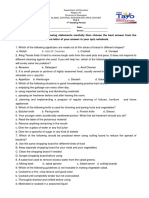Come To Where The Copper Is - Modern Ore Mining in Chile: Report by Arne Kristoffer Bayer, Reik Michael Winkel, Germany
Come To Where The Copper Is - Modern Ore Mining in Chile: Report by Arne Kristoffer Bayer, Reik Michael Winkel, Germany
Uploaded by
dr chatti hanumantha raoCopyright:
Available Formats
Come To Where The Copper Is - Modern Ore Mining in Chile: Report by Arne Kristoffer Bayer, Reik Michael Winkel, Germany
Come To Where The Copper Is - Modern Ore Mining in Chile: Report by Arne Kristoffer Bayer, Reik Michael Winkel, Germany
Uploaded by
dr chatti hanumantha raoOriginal Title
Copyright
Available Formats
Share this document
Did you find this document useful?
Is this content inappropriate?
Copyright:
Available Formats
Come To Where The Copper Is - Modern Ore Mining in Chile: Report by Arne Kristoffer Bayer, Reik Michael Winkel, Germany
Come To Where The Copper Is - Modern Ore Mining in Chile: Report by Arne Kristoffer Bayer, Reik Michael Winkel, Germany
Uploaded by
dr chatti hanumantha raoCopyright:
Available Formats
Field Trip Report
World of Mining Surface & Underground 56 (2004) No. 5
Come to where the copper is Modern ore mining in Chile
Report by ARNE KRISTOFFER BAYER, REIK MICHAEL WINKEL, Germany
A group of Aachen University students and staff of the excavation and mining equipment group (BGMR) visited a number of Chilean mines and equipment suppliers in autumn 2003 within the scope of a eld trip. In this paper two of the largest and most modern open pit copper mines of the leading South American mining nation will be presented: The Chuquicamata mine, run by the state owned Codelco, and the Escondida mine, operated by an international consortium. The main focus is put on the mining and processing operations. Besides, geology and metallurgical processes are described.
Introduction
Within the scope of a eld trip, a group of Aachen University students and staff of the excavation and mining equipment group (BGMR) had the opportunity to travel Chile (Figure 1). The extensive itinerary included several mine site visits on surface and underground (copper and limestone) plus the visitation of branch
In this paper the following two copper mines will be covered in detail: The open pit copper mine of Chuquicamata in the Atacama desert is one of the largest of its kind in the world in terms of mine site area. It is operated by the state owned Codelco Chile (Corporacin Nacional del Cobre). Escondida, operated by an international consortium consisting of BHP Biliton, Rio Tinto and a Japanese investor, produces annually more than one million tons of copper in metal content being the biggest copper mine in the world. Since decades Chile is considered to be one of the world most important mining nations. In 2002 about 4.6 mill t of copper were mined adding up to a third of the total annual world production. Besides more than 30 % of all copper ore reserves are located in the Chilean Andes. Important by-products of the copper mining operations are gold and silver. Additionally Chile is one of the key producers of natural nitrates, iodine, lithium and sulphates. The value of 2001s exports of mining products exceeded 7.5 bn US$ counting for 44 % of the overall Chilean exports [1].
Chuquicamata open pit
The Chuquicamata open pit is located some 250 km north of the coastal city of Antofagasta and 1200 km north of the capital Santiago de Chile at an altitude of 2800 m. For as early as 1910 the mining of copper was commenced by the US American Chile Exploration Mining, later Anaconda Mining. Since 1971 the open pit belongs to Codelco Chile. Today some 6500 workers are employed, who produce around 600,000 t of copper and 14,000 t of molybdenum per annum. Over its entire mine life Chuquicamata has produced so far almost 35 mill t of copper, corresponding with 2.5 times the recent annual world copper consumption.
Fig. 1: Participants of the BGMR eld trip in the village of Chuquicamata
2.1
Geology
ofces of equipment suppliers like Sandvik Tamrock, Atlas Copco and Lanzco. Additionally the group saw two plants producing lithium and borates of the world market leader Soquimich and exchanged scientic experiences with colleagues from the Universidad de Chile in the Chilean capital Santiago de Chile. The general perspective of the Andean country was concluded by numerous cultural sights and the visit of the European Southern Observatory (ESO). DIPL.-ING. ARNE KRISTOFFER BAYER, since July 2004: Roland Berger Strategy Consultants, CC Utilities, Karl-Arnold-Platz 1, 40474 Dsseldorf, Germany Tel. +49 (0) 211-43 89-2157, Fax +49 (0) 211-43 89-2172 e-mail: arne_bayer@de.rolandberger.com DIPL.-ING. REIK MICHAEL WINKEL, Excavation and Mining Equipment Group (BGMR), Aachen University, Research Engineers, Lochnerstr. 4-20, 52064 Aachen, Germany e-mail: winkel@bgmr.rwth-aachen.de 380
A signicant feature of the copper porphyry complex of Chuquicamata is the deep supergeneous mineral enrichment, which could be proven to a depth of 1000 m. The ore reserves are estimated at some 13 bn t with an average copper content of 0.8 %. Mina Sur is located south of the ore body and in the north the Radomiro Tomic open pit commenced mining three years ago (Figure 2), combined the three mines form the Codelco Chiles Division Norte. The sulphide ore is oxidised to a depth of between 100 and 200 m below ground level. Since the introduction of the hydrometallurgical Solvent Extraction/Electro winning method (SX-EW) these ore type can be utilized at low specic costs. The treatment of Run of Mine (ROM) ore with copper contents as low as 0.3 % is still economical feasible. The Chuquicamata open pit is situated on the eastern side of the mineralization and fault system extending for 14 km. West of this system almost no mineralization is encountered. To mine the ore the open pit has to push deeper handling an increasing amount of waste rock material. The geomechanical properties of the unstable waste rock just allow for a slope angle of 30 to 32 whereas on the ore side of the pit angles of 42 result in stable
World of Mining Surface & Underground 56 (2004) No. 5
Field Trip Report
Fig. 2: View on the Chuquicamata mine in northern direction. Centre: Waste dump; Centre top: open pit Chuquicamata and in the background the open pit Radomiro Tomic; Centre right: smelter; bottom left: the village of Chuquicamata; bottom right: Mina Sur (Southern pit)
slopes. Because of these conditions an ore to waste ratio of about 1:2 is encountered at Chuquicamata.
2.2
Mining operation
Depending on the copper content the ore is mined selectively and treated in separate processing lines. The current cut off grade for sulphide ores, which are otated, is set at 0.6 % copper content. Per annum 60 mill t of ore averaging 1 % copper are processed and additional 10 mill t with 0.6 % Cu are mined and stockpiled. Starting from 2015 this material will be blended with the ROM, as at that point of time the average copper content will decrease to about 0.5 %. Some 10 mill t of oxide ore (0.2 to 0.5 % Cu) are mined annually and heap leached. With annually 150 mill t, waste rock makes up most of the material being moved in the Chuquicamata copper operation. The blasting takes place on a daily basis at 5 pm. Ingersoll Rand drill rigs create the 20 m, 310 mm holes in a 6.5 m x 13 grid. To stabilize the nal pit slopes smaller holes ( 165 mm) are drilled at the perimeter of the pit. Per day 400 t of ANFO explosives (Ammonium Nitrate and Fuel Oil) are used, where encountering water bearing strata emulsion is used instead. Over the last years the bench height has been standardized to 18 m. The blasted material is loaded with P&H rope shovels having volumes of 26, 43 respectively 55 m. Auxiliary tasks are performed by Komatsu dozers. For transportation purposes Liebherr T 282 B trucks with a payload of 360 t, as well as Caterpillar 793 are used (Figure 3). Until 2000 the waste rock has been transported via an in pit crusher on a belt conveyor installed by Rheinbraun Engineering. The advance of the open pit and layout changes were the reasons to stop the system. To reduce transport costs a new conveyor system running through a tunnel will be installed in 2005. Since lately the short term mine planning is supported by a dispatching system as used in the neighbouring Radomiro Tomic pit already from the rst ton of ore mined in 2000. The long term planning at Chuquicamata is scheduled until 2025.
Fig. 3:
P&H 4000 rope shovel, CAT 793 truck, Komatsu dozer
overall recovery of the processing plant amounts 87 % at 1 % copper in the ROM ore compared to 60 % for the molybdenum at 0.04 % Mo. The copper concentrate averages 30 % Cu, 2 % Zn and 0.6 % As. Especially the arsenic content is the reason for not exporting the copper concentrate but to treat pyrometallurgically already on site. Despite recent successes in ltering technology the management decided to resettle the village of Chuquicamata to Calama some 20 km away due to the high arsenic contamination of the atmosphere and the ground water. Current R&D activities of the Codelco Division Norte are aiming at introducing the more environmentally friendly bio-leaching; a pilot plant utilizing bacteria to dissolve the copper has been installed. The oxide ore is processed to cathode copper via heap leaching and electrolysis. By this means the huge amounts of sulphuric acid resulting from the ue gas desulphurization in the smelter unit can be utilised.
2.3
Processing and Rening
2.4
Economics
In the rst stage of the milling process the sulphide ROM ore is fed into autogenous mills and in a second stage into semi autogenous ball mills to obtain the nal grain size of 100 m. The
The protability of the mining operation is declining, as the mining operation is getting deeper and consequently the ore to waste ratio is deteriorating. The operative cash costs in 2002 were reported 381
Field Trip Report
at 39.6 US cent per pound of copper. A cost reduction of one US cent/lb equals a mine life extension of 1.6 years. Therefore optimisations of the mining operations are crucial for the management like the evaluation of alternative ways to extract the copper ore. In the future an underground operation is thought to be economical and initial projects are looking at possible mine designs. The panel caving with pre-undercutting mining method as applied at Codelcos El Teniente copper mine is considered as the method of choice. Codelco Chile generated in 2002 a turnover of 3.49 bn US$ generating a prot of 369 mill US$. 326 mill US$ were transferred to the Chilean state. The mid term strategy of the copper giant is to double the company value. Massive cost reductions in current operations and an intensive investment and modernisation program, as well as several green eld projects should manifest Codelco Chiles position as one of the lowest cost copper producer in the world.
World of Mining Surface & Underground 56 (2004) No. 5
nite. Certain areas of the reserve are covered by copper oxides. 2002 the proven reserves of sulphide ore were some 702 mill t averaging 1.45 % of copper and resources of 843 million t (1.02 % Cu). Additionally about 143 million t of oxide ores with an average copper content of 0.77 % are proven. The remaining life time of the Escondida open pit at the current extraction rate is estimated to 40 years.
3.2
Mining operation
Escondida open pit
The copper ore both sulphides and oxides is mined using conventional drill and blast technology. The current ore to waste ratio amounts to 1.7:1 and is expected to stay in that range throughout the entire mine life. At the moment the open pit has a diameter of 2500 m and the deepest level is situated at 800 m below surface. Table 1 lists up Escondidas current equipment eet.
Tab. 1: Drill rigs Technical data of Econdidas mining equipment 8 B-E 49 R respectively 49 R III (electro driven) 2 P&H 250 XP (electro driven) 1 Ingersoll Rand DMM2 (diesel driven) 9 rope shovels B-E 495 (38, 40 and 42 m) 2 rope shovels P&H 4100 XPB (56 m) 24 CAT 793B, 28 Komatsu 830-E and 23 CAT 793C 218 t; 13 CAT 797 340 t 3 LHD CAT 980 (17,5 m), Dozer, Grader, water trucks
The Escondida copper mine is located some 160 km east of the coastal town of Antofagasta at an altitude of 3050 m above sea level. The mine is operated since the early 1990s by an international consortium consisting of BHP Billiton (57.5 %), Rio Tinto (30 %), a Japanese investor (10 %) and the International Finance Corporation (2.5 %). Since the rst shovel mined the daily production has been increased continuously. These days the 2300 workers and 1900 contractors mine every day on average some 960,000 t ROM ore and waste rock. Whereas in 1991 the annual copper production was 260,000 t in 2003 the million ton per year line was broken. After nishing the Phase IV extension last year the maximum installed capacity of Escondida amounts to 1.25 mill t of copper in concentrates and cathodes. Mina Escondida alone produces some 7 to 8 % of the annual world copper production. The total investment since 1981 sums up to 3.8 billion US$. The mine impresses visitors with cutting edge mining equipment and methods: Apart from the technical point of view the AngloAmerican management installed a modern organisation and the whole mine site presents itself as up to date and very tidy in comparison to other South American operations (Fig. 4).
Excavators Trucks Auxiliary equipment
3.1
Geology
Three different porphyries form the mineralization of the Escondida mine. Primary sulphide minerals are pyrite, chalcopyrite and bor-
Because of the absence of ground water comparably cheap ANFO explosives can be used to break the material. Electronical detonators have to be applied, as atmospheric disturbances are quite common in the arid climate of the Atacama Desert. The design of the drilling pattern is determined by the principle mine to mill, the blasted material should be characterised by a grain size distribution that minimizes the amount of energy in the crushing und milling process. The ROM ore is crushed in-pit and transported via belt conveyors to the processing plant. All trucks and moving vehicles in the pit, as well as all transportation and logistics are coordinated by a dispatching system manufactured by Wenco International Mining Systems, whereas quality control, maintenance and repair activities are realised using Mincoms pit information system.
Fig. 4: Aerial view of the Escondida open pit
382
World of Mining Surface & Underground 56 (2004) No. 5
Field Trip Report
3.3
Processing and Rening
Depending on the ore type two different ways in processing the copper ore are encountered in the Escondida open pit. The oxide ores are heap leached and the sulphuric acid dissolves the copper. In the so called Planta de xido copper cathodes are produced using the hydrometallurgical SX/EW-process. During the solvent extraction stage the copper bearing solution is cleaned and enriched. The pregnant solution contains on average 40 g/l of copper and 0.18 g/l of arsenic. The last stage is the electrolysis. The sulphide ore is processed by means of otation to copper concentrate containing about 36 % copper. This process has a recovery rate of 85 %. The daily throughput of the processing plant is a maximum of 230,000 t/d. The grain size of the ore after passing the autogenous (Figure 5) and semi autogenous ball mills is less than 100 m. The otation process in the rougher and cleaner stages is taking place in Wemco column cells with a volume of 194 m. The nes are deposited in waste ponds and the water is being recovered to be reused in the process. To minimize the evaporation of the resource water, sun reecting, hexagonal dipyramidal plastic balls are covering the surface of the ponds.
Fig. 6:
Port facilities at Coloso
3.6
Contribution to the Community
Fig. 5:
Processing of sulphide copper ore (Autogenous mills)
3.4
Transport and Logistics
The copper concentrate is transported from the Escondida mine to the port facilities in Coloso via a 170 km pipeline ( 9 inch, HDPE liner). The rst 9 km the slurry has to be pumped, afterwards the mix ows by gravity towards the Pacic Ocean (2 m/s). Disk lters reduce the water content to about 9 %. The embarkation is done using a special conveyor construction (Figure 6) enabling the loading of 45,000 t vessels with 1200 t/h. The residual water is cleaned from heavy metal contamination and then charged into the Pacic. The main consumers of the copper concentrate are Japanese smelters (28 %) and the German Norddeutsche Afnerie (NA) in Hamburg (11 %).
The activities of the mining company are not singularly focussed on the production of copper but Minera Escondida strongly emphasizes its responsibility for the community and the environment. It committed itself to invest some 1 % of the annul earnings before tax in community projects in the vicinity. For example schools in the city of Antofagasta are sponsored and research contracts are signed with local universities. Additionally the inhabitants of the settlement of Coloso are provided with electricity and infrastructure. In the recent ve years, the social contributions added to some 21 mill US$. Acknowledgement The realisation of the technical excursion would not have been possible without the nancial support of numerous sponsors from industry and organisations. Standing for all, the foundation Prof. Dr. Berg.-Ing. H. Goergen und Frau Elisabeth-Stiftung, Aachen, and the German academic exchange service (DAAD), Bonn, should be named in this context. Many thanks as well to Lanzco, Santiago de Chile, for the assistance organizing the eld trip.
3.5
Economics
The difcult situation of the world copper market in 2002 forced Minera Escondida to reduce the production gures by some 144,000 t. The world marked price in this period was at 70.3 US cent per pound. The turnover generated in 2002 accounted to 933 mill US$ generating a prot of 143.6 mill US$. The cash cost on an operational base were reported at 53.2 US cent, the cash costs after interest amounted to 59.6 US cent per pound of copper.
References
[1] [2] V ELASCO , P., The Minerals Industry of Chile 2001, US Geological Survey, http://minerals.usgs.gov/minerals Interviews with staff members and brochure material, Codelco Chile (www.codelco.cl) and Minera Escondida (www.escondida.cl)
383
You might also like
- Paper # 013 - 10 Years of History of Antamina's Sag MillDocument15 pagesPaper # 013 - 10 Years of History of Antamina's Sag MillrmpalmavNo ratings yet
- Goode 1993 (Tails Reclaim)Document16 pagesGoode 1993 (Tails Reclaim)john_goodeNo ratings yet
- Production of Cobalt From Copper-Cobalt Ores On The African Copperbelt - An Overview PDFDocument16 pagesProduction of Cobalt From Copper-Cobalt Ores On The African Copperbelt - An Overview PDFRodrigoNo ratings yet
- Perceptual MapDocument17 pagesPerceptual Mapthu_bui_18100% (1)
- Hydrometallurgy in Codelco Norte: Division Production KT Copper Net Cost US$/lbDocument12 pagesHydrometallurgy in Codelco Norte: Division Production KT Copper Net Cost US$/lbLuis Paulo Medina ArévaloNo ratings yet
- Mina El SoldadoDocument6 pagesMina El SoldadoYorky Edgardo CastilloNo ratings yet
- Falcondo Revisted 07 - 02Document14 pagesFalcondo Revisted 07 - 02Indra Setiawan SunarjaNo ratings yet
- Minerals: Copper Bioleaching in ChileDocument9 pagesMinerals: Copper Bioleaching in ChileAgustin LeónNo ratings yet
- 8.2 Introduction To Mining and Mineral ProcessingDocument58 pages8.2 Introduction To Mining and Mineral ProcessingTamani Moyo100% (1)
- Info MineDocument10 pagesInfo MineUpdatest newsNo ratings yet
- Bauxite Mining Micro-Project - Report Writing Report of Bauxite MiningDocument19 pagesBauxite Mining Micro-Project - Report Writing Report of Bauxite MiningVaibhav SNo ratings yet
- 083 Pioneering Mass Caving at El TenienteDocument8 pages083 Pioneering Mass Caving at El TenienteKenny CasillaNo ratings yet
- 4c578f202616448 - Ek #1Document72 pages4c578f202616448 - Ek #1Alek Al HadiNo ratings yet
- 2015jones CopperDocument6 pages2015jones CopperRunkitoNo ratings yet
- JMR&T Environmental, Economical and Technical Aspects Smelters in ChileDocument13 pagesJMR&T Environmental, Economical and Technical Aspects Smelters in Chileisabel gutierrezNo ratings yet
- PWC Basics of Mining 2 Som Mining MethodsDocument75 pagesPWC Basics of Mining 2 Som Mining Methodsaxel_gutierrez_11No ratings yet
- Final Year Project Thesis Guide: School of Advanced Manufacturing and Mechanical EngineeringDocument18 pagesFinal Year Project Thesis Guide: School of Advanced Manufacturing and Mechanical EngineeringSuseendaran BabuNo ratings yet
- Victory Nickel Minago Project Feasibility Study 2009 Executive Summary PDFDocument40 pagesVictory Nickel Minago Project Feasibility Study 2009 Executive Summary PDFYeneyaeNo ratings yet
- Primer Examen MetodosDocument9 pagesPrimer Examen MetodosDaniel Yana BernabéNo ratings yet
- Tin-From Ore To IngotDocument6 pagesTin-From Ore To IngotAbdullah Badawi BatubaraNo ratings yet
- Solvent Extraction in Southern AfricaDocument27 pagesSolvent Extraction in Southern AfricaYassine GouzzaliNo ratings yet
- Assessment of Dust Generation Due To Opencast Coal Miningan Indian Case StudyDocument9 pagesAssessment of Dust Generation Due To Opencast Coal Miningan Indian Case Studysaurabh shrivastavaNo ratings yet
- Mining For Diamonds - History and Present: J. JakubecDocument3 pagesMining For Diamonds - History and Present: J. JakubectamanimoNo ratings yet
- 1632 Puhlmann BR PDFDocument10 pages1632 Puhlmann BR PDFalinoriNo ratings yet
- Acid Pressure Leaching of Copper Sulfides: Delivering Smarter SolutionsDocument4 pagesAcid Pressure Leaching of Copper Sulfides: Delivering Smarter SolutionsSerchecko JaureguiNo ratings yet
- Pongkor Process Plant OverviewDocument17 pagesPongkor Process Plant OverviewImam SidikNo ratings yet
- Kinsevere Presentation February 2016 PDFDocument16 pagesKinsevere Presentation February 2016 PDFJSNo ratings yet
- Admin,+12 Vega+M,+Zaror+CDocument10 pagesAdmin,+12 Vega+M,+Zaror+Cuna_vegaNo ratings yet
- 2020-09-15 South Crofty Drill Results 2Document4 pages2020-09-15 South Crofty Drill Results 2editorialmiovNo ratings yet
- A Comparison of BHP Billiton Mineral Escondida Flotation ConcentratorsDocument22 pagesA Comparison of BHP Billiton Mineral Escondida Flotation ConcentratorsNathalie Jamett GuillierNo ratings yet
- Preprints202306 1368 v1Document23 pagesPreprints202306 1368 v1praveengune3No ratings yet
- Dasar Dasar NikelDocument13 pagesDasar Dasar NikelEvangelista LindaNo ratings yet
- Paper - Mine Waste 1Document3 pagesPaper - Mine Waste 1Manoj TiwariNo ratings yet
- Leach S X Ew Production Oof CopperDocument10 pagesLeach S X Ew Production Oof CopperJeromeNo ratings yet
- Cutoff-Grade Analysis at Fazenda Brasile PDFDocument12 pagesCutoff-Grade Analysis at Fazenda Brasile PDFJoão BatistaNo ratings yet
- Undergraduate Project Report: "A Review On Underground Metal Mine Workings in Developed Countries"Document42 pagesUndergraduate Project Report: "A Review On Underground Metal Mine Workings in Developed Countries"Ankush TyagiNo ratings yet
- Kennecott Utah Copper's Bingham Canyon Mine: Teacher GuideDocument6 pagesKennecott Utah Copper's Bingham Canyon Mine: Teacher Guideitalodex100% (1)
- Blast Fragmentation Optimization at Tarkwa Gold Mine Using 6 Sigma Methodologies. Miss Alexandra Amiel Goldfields Ghana LTD Tarkwa Gold Mine - UsarDocument24 pagesBlast Fragmentation Optimization at Tarkwa Gold Mine Using 6 Sigma Methodologies. Miss Alexandra Amiel Goldfields Ghana LTD Tarkwa Gold Mine - UsarFabio OliveiraNo ratings yet
- Coal MiningDocument13 pagesCoal MiningSirad Hirsi0% (1)
- Surface Mining An ItroductionDocument6 pagesSurface Mining An ItroductionnathansolaiNo ratings yet
- Simulation of Processing Minerals Plants in Colombia Through Modsim®Document8 pagesSimulation of Processing Minerals Plants in Colombia Through Modsim®Paula Andrea Celis PinedaNo ratings yet
- Afrik'Mines FaisabiliteDocument58 pagesAfrik'Mines FaisabiliteMouhamadou Mansour WadeNo ratings yet
- Explanation Kyanite, Andalusite and Sillimanite in ProductionDocument5 pagesExplanation Kyanite, Andalusite and Sillimanite in ProductionSteven Luis Maiz CespedesNo ratings yet
- Copper in ChileDocument2 pagesCopper in ChileNicole SilvaNo ratings yet
- A Review Study On The Extraction of Nickel From Its OresDocument44 pagesA Review Study On The Extraction of Nickel From Its OresAqila AbizardNo ratings yet
- Positive Pre-Feasibility Outcome For Cloncurry Copper ProjectDocument13 pagesPositive Pre-Feasibility Outcome For Cloncurry Copper Projectsbirol5409No ratings yet
- CMX Roadshow Final Oct 27 2016Document25 pagesCMX Roadshow Final Oct 27 2016dpbasicNo ratings yet
- 5.The Technological Enhancement of Normally OccurrinDocument8 pages5.The Technological Enhancement of Normally Occurrinsharad patilNo ratings yet
- Red MudDocument2 pagesRed MudManish Kumar100% (1)
- UMM3 CompleteDocument156 pagesUMM3 CompleteJhonatan Marlon Ramon Arzapalo100% (2)
- Hidrometallurgy of CobaltDocument11 pagesHidrometallurgy of CobaltJorge Alexander Rocha Alvarez100% (4)
- Preliminary Feasibility Study Confirms Cinovec As Potentially Low Cost Lithium Carbonate ProducerDocument23 pagesPreliminary Feasibility Study Confirms Cinovec As Potentially Low Cost Lithium Carbonate ProducerSudarshan ChoudharyNo ratings yet
- Bomasang Magazine 1Document11 pagesBomasang Magazine 1Jelaica100% (1)
- NickelDocument43 pagesNickelLastilloNo ratings yet
- Mineralogical Variations With The Mining Depth in The Congo Mineralogical Variations With The Mining Depth in The CongoDocument21 pagesMineralogical Variations With The Mining Depth in The Congo Mineralogical Variations With The Mining Depth in The CongoMichel M.No ratings yet
- Green energy? Get ready to dig.: Environmental and social costs of renewable energies.From EverandGreen energy? Get ready to dig.: Environmental and social costs of renewable energies.Rating: 5 out of 5 stars5/5 (1)
- Extractive Metallurgy 2: Metallurgical Reaction ProcessesFrom EverandExtractive Metallurgy 2: Metallurgical Reaction ProcessesRating: 5 out of 5 stars5/5 (1)
- Summary of Guillaume Pitron's The Rare Metals WarFrom EverandSummary of Guillaume Pitron's The Rare Metals WarRating: 4 out of 5 stars4/5 (2)
- Sedimentary Mineral AssociationsDocument18 pagesSedimentary Mineral Associationsdr chatti hanumantha raoNo ratings yet
- Certification As Coal Geologist (CCG) : T A A P G, I - D P ADocument4 pagesCertification As Coal Geologist (CCG) : T A A P G, I - D P Adr chatti hanumantha raoNo ratings yet
- Airtel Care AddressesDocument4 pagesAirtel Care AddressesHarish KapoorNo ratings yet
- Soda AshDocument10 pagesSoda Ashdr chatti hanumantha rao0% (1)
- Community Diagnosis FinalDocument116 pagesCommunity Diagnosis FinalAriane Ballaret75% (8)
- TLE 9 CookeryDocument3 pagesTLE 9 CookeryVan TotNo ratings yet
- Soalan Tugasan HBSE3303 OUMDocument5 pagesSoalan Tugasan HBSE3303 OUMTutor EvonNo ratings yet
- فوكاب 4m3 متوسط فاينال 1 1Document28 pagesفوكاب 4m3 متوسط فاينال 1 1vxxv11vvNo ratings yet
- Insurance in A Box Brochure 10 24 2017Document4 pagesInsurance in A Box Brochure 10 24 2017Markito TrpeskiNo ratings yet
- Roots-Part 1-Numerical MethodsDocument18 pagesRoots-Part 1-Numerical MethodsMohamed OsamaNo ratings yet
- hcr263 Group Activity Coding Presentation 3Document19 pageshcr263 Group Activity Coding Presentation 3api-682342806No ratings yet
- CukDocument28 pagesCukEdon DergutiNo ratings yet
- BoutecaDocument12 pagesBoutecaPiotr PrzecherskiNo ratings yet
- Evaluation of Area Traffic Management Measures Using Microscopic Simulation ModelDocument10 pagesEvaluation of Area Traffic Management Measures Using Microscopic Simulation ModelLokesh KNo ratings yet
- Alarm Sounder FDS221 Technical ManualDocument52 pagesAlarm Sounder FDS221 Technical ManualBilbureanu Robert FlorinNo ratings yet
- Exam 3Document11 pagesExam 3awais04No ratings yet
- Blender With Open FoamDocument25 pagesBlender With Open FoamstyleworkerNo ratings yet
- Solving Questions of Ethics in Social and Political Philosophy - CADocument5 pagesSolving Questions of Ethics in Social and Political Philosophy - CAAllison BoydNo ratings yet
- Optical Illusions IDocument100 pagesOptical Illusions IIzzah AlHusnaNo ratings yet
- Magazine 2023 ONLINE SmallDocument37 pagesMagazine 2023 ONLINE SmallBrendan JohnsonNo ratings yet
- Solved Examples in Bearing Capacity of Shallow FoundationsDocument10 pagesSolved Examples in Bearing Capacity of Shallow FoundationsMohamed A7ham100% (4)
- 100 Alien Abduction StoriesDocument106 pages100 Alien Abduction StoriesJohn SuttonNo ratings yet
- Compartment ModellingDocument46 pagesCompartment ModellingBio DataNo ratings yet
- MME-Electrical-Session-2 Network Theorems PDFDocument74 pagesMME-Electrical-Session-2 Network Theorems PDFgpuonlineNo ratings yet
- Integrated Software ApplicationsDocument82 pagesIntegrated Software Applicationsadrian quintoNo ratings yet
- Best Time To Buy and Sell Stock: Example 1Document6 pagesBest Time To Buy and Sell Stock: Example 1gobichand7No ratings yet
- Laboratory Analysis - GGU SoftwareDocument2 pagesLaboratory Analysis - GGU Softwareindrajit sodhaNo ratings yet
- MCQDocument8 pagesMCQSUDHA .BNo ratings yet
- Pylontech US5000C 48KWh 48VDocument2 pagesPylontech US5000C 48KWh 48Vliarubio0619No ratings yet
- Symmetric EncryptionDocument3 pagesSymmetric EncryptionrishiNo ratings yet
- It100-1 2Document6 pagesIt100-1 2Kanton FernandezNo ratings yet
- hrs6600 s2Document18 pageshrs6600 s2Tv21 OrgNo ratings yet
- Javascript Complete NotesDocument36 pagesJavascript Complete NotesterencefreefireNo ratings yet





